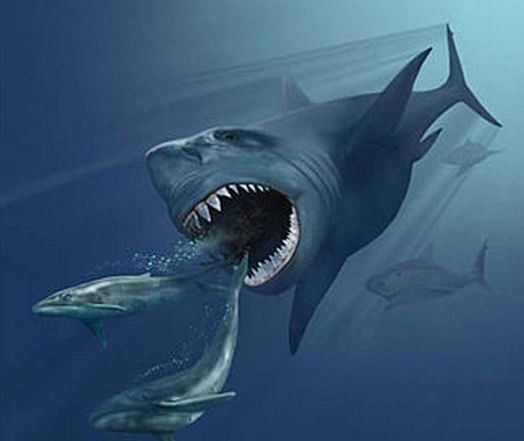Megalodon, a Super Shark, Could Tear Whales in Half
| Arthur Dominic Villasanta | | Feb 20, 2015 10:09 PM EST |
Megalodon chasing two small whales. Artist's impression.
Ever wonder why whales such as the Blue Whale and the Baleen Whale have gotten so big they're now the largest mammals on Earth?
The fact they eat tons of krill and plankton is a major reason. But frequently overlooked is that whales today have no natural predators.
Sure Killer Whales do kill other whales such as baleens (80 feet long) but the size of an Orca (around 30 feet long) doesn't make them a threat to entire whale family. Not so from 16 to 2.6 million years ago when the biggest shark that ever lived chowed-down on whales and kept their numbers in check.
Like Us on Facebook
Megalodon (Carcharocles megalodon) ranged in size from 45 feet to 60 feet, not far off from today's Blue Whale with a length of about 100 feet. Megalodon is best described as an super-sized Great White (20 feet long) that seemed to have a liking for baleens.
Fossils of baleen whales are often found along with Megalodon teeth. The word Megalodon, by the way, means "big tooth". The largest Megalodon teeth found measured seven inches.
Scientists point out baleen whales at the time Megalodon ruled the waves were much smaller in size than they are today. The same can be said for other whale species today. The question is "Why"?
"When we found out when that happened, we noticed it coincided with the pattern mentioned in whales. Now we need to find out if one event - Megalodon's extinction - caused the other - evolution of gigantism in whales", said Catalina Pimiento from the Florida Museum of Natural History who co-authored a study about megalodon and why today's whale reached their enormous sizes.
She noted this was a first step in ongoing research to understand the disappearance of Megalodon.
"From modern sharks, it is known that larger individuals have a broader range of prey size, including larger prey. That means that the larger prey will be predated mostly by larger sharks."
She noted that after megalodon's extinction 2.6 million years ago between the Pliocene and Pleistocene epochs, baleen whales began to grow to their gigantic sizes today.
The findings were published in the journal, Plos One.
©2015 Chinatopix All rights reserved. Do not reproduce without permission
EDITOR'S PICKS
-

Did the Trump administration just announce plans for a trade war with ‘hostile’ China and Russia?
-

US Senate passes Taiwan travel bill slammed by China
-

As Yan Sihong’s family grieves, here are other Chinese students who went missing abroad. Some have never been found
-

Beijing blasts Western critics who ‘smear China’ with the term sharp power
-

China Envoy Seeks to Defuse Tensions With U.S. as a Trade War Brews
-

Singapore's Deputy PM Provides Bitcoin Vote of Confidence Amid China's Blanket Bans
-

China warns investors over risks in overseas virtual currency trading
-

Chinese government most trustworthy: survey
-

Kashima Antlers On Course For Back-To-Back Titles
MOST POPULAR
LATEST NEWS
Zhou Yongkang: China's Former Security Chief Sentenced to Life in Prison

China's former Chief of the Ministry of Public Security, Zhou Yongkang, has been given a life sentence after he was found guilty of abusing his office, bribery and deliberately ... Full Article
TRENDING STORY

China Pork Prices Expected to Stabilize As The Supplies Recover

Elephone P9000 Smartphone is now on Sale on Amazon India

There's a Big Chance Cliffhangers Won't Still Be Resolved When Grey's Anatomy Season 13 Returns

Supreme Court Ruled on Samsung vs Apple Dispute for Patent Infringement

Microsoft Surface Pro 5 Rumors and Release Date: What is the Latest?










